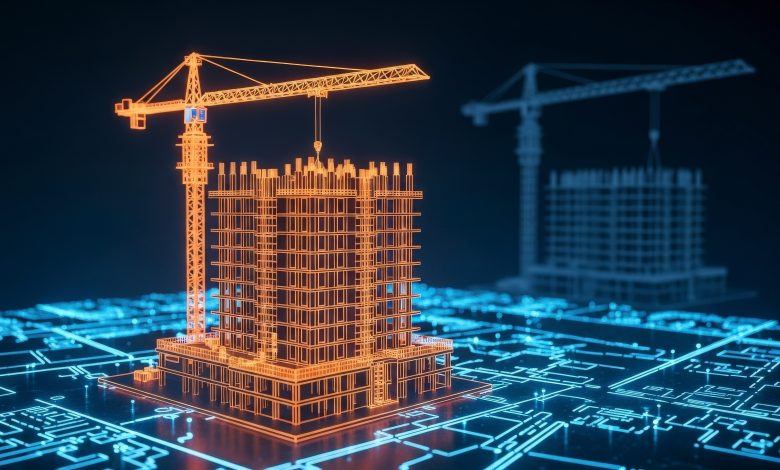
As artificial intelligence (AI) advances and construction site theft increases, AI offers significant improvements for on-site and online security. With annual losses reaching £1 billion in the UK, integrating AI into surveillance systems is essential to reduce theft and shift strategies from reactive to proactive. AI enables a proactive approach to cybersecurity, moving beyond traditional CCTV systems that rely on slower human monitoring and are more susceptible to missed threats and vulnerabilities.
As AI-integrated systems now detect and deter threats, it’s consequential for businesses to adopt more vigilant security strategies. However, enhanced security is often accompanied by concerns and anxiety around surveillance culture and data privacy. This emphasises the need for a balanced approach, where advancements in AI-driven surveillance are matched with robust data protection. Transparent policies and ethical guidelines are necessary to ensure that security does not compromise privacy or foster distrust.
Construction as a Target
The UK is facing a cyber catastrophe, with businesses losing £1,600 on average due to disruptive breaches, and ransomware attacks costing the economy an estimated £27 billion annually. The construction industry is increasingly experiencing cyber threats due to its reliance on digital tools, and as the handling of high-value contracts and sensitive data is converting to digital, IoT, and CCTV act as entry points for attacks. “Theft isn’t just about stolen equipment, but it breeds lack of trust between employees, stumps productivity, and pushes back deadlines,” states Mark Hastry, Chief Technology Officer at Wireless CCTV. “Cyber crime and theft used to be separate issues, but now, within the construction industry, they’re converging.”
Physical site theft is a significant problem, especially for project deadlines and costs to replace stolen equipment. It directly pauses operations and is damaging to a construction business’s reputation, potentially causing contractual penalties, damaging client relationships, and losing industry trust. Theft creates a heavy financial burden, from replacing equipment to rising insurance premiums, leaving construction sites to invest in more expensive security measures. As sites adopt more security measures, including CCTV, and due to the expensive equipment and high-value contracts, cyber criminals are looking at construction sites as attractive targets.
If IoT and CCTV systems are penetrated by criminals, the consequences can be extreme. As cyber criminals target data, the consequences could be malicious, with criminals using the data to commit fraud and identity theft, resulting in a breach of contract between the clients and site, further damaging the reputation of the construction business, and reducing the volume of interest from potential clients.
Given £1 billion in annual losses from theft, site managers must adopt more advanced security solutions. Traditional CCTV only records incidents and cannot prevent crime in real-time. Due to competing demands, site managers cannot continuously monitor footage or respond proactively. However, as more sites use IoT and CCTV to prevent theft, these same systems can become entry points for cybercrime, leading to a convergence of physical and digital risks.
AI as a Partner
Businesses should begin with targeted AI deployments before expanding across operations, for example, with AI-integrated surveillance systems, abnormalities captured on video can be flagged for the user. Site managers can train AI models to notice unusual patterns on-site and online. Users of cloud-based CCTV can deter theft in real-time through the use of audio-deterrence, facial recognition, and tracking movement. Thanks to the cloud and AI, footage is uploaded instantly, alerting users to share with authorities. Predictive safety analytics are now being implemented within AI models deployed within CCTV cameras, identifying potential accidents or equipment failures before they occur.
AI-human collaboration is essential, and isn’t here to replace humans. “A human might be monitoring one screen, but AI can monitor thousands simultaneously and spot risks within seconds”, Hastry commented, “and as the shift turns to crime becoming online too, AI acts like a teammate, someone who is always one step ahead”. To build on this, a human needs to be the one to make the final decision on a threat, either online or on-site, to ensure there is not over-dependency on AI.
Site risks aren’t just physical, and as threats become digital, robust security measures are essential. Rather than focusing on large AI models, it is generally recommended to start small and scale accurately to report on ROI, maintain compliance, and ensure a seamless integration. According to Microsoft’s research, businesses that integrate AI into their cybersecurity are twice as resilient to attacks, suffering 20% less in losses.
Traditional cybersecurity waits for a breach to occur before taking action, whereas AI can monitor the traffic and shut down any suspicious access before it escalates. AI can spot unrecognised logins, unusual malware behaviour, and data movement quicker than a human could, proving to be crucial with 24-hour construction sites. Although AI-human collaboration is necessary, AI can drastically reduce human error and flag if an employee is showing unsafe behaviour, such as uploading confidential files onto a server with a compromised account. Cybercriminals constantly adopt new tactics, and the time for more agile security measures is now.
Combatting Ethical Complications
Maintaining trust within a business is crucial. The introduction to AI-operated systems can be daunting; employees will have many questions and concerns, but it is possible for employees to feel confident with the integration. Hastry emphasises, “The conversation about AI in surveillance is as much about trust as it is about technology”. Establishing the correct training, complete transparency, and human oversight can reduce concerns, and gradually introducing AI helps employees adjust and trust the model, showing that AI can enhance safety without being invasive.
What makes today’s threats so dangerous is the potential convergence, as the CCTV that is there to protect physical site theft is also the entry point for cyber criminals, and AI must be prepared to handle the convergence. In a survey done by The SCXchange, 78% of respondents cited data privacy as the top ethical concern in AI adoption. By creating false, but realistic scenarios, synthetic data can train AI models on patterns, behaviour, and only flag what’s necessary, ensuring privacy for employees on site and reducing false alarms. For example, training models to recognise patterns over faces for premises breaches and only monitoring specific areas of the site (and not smoking areas) reduces employees’ fear of being watched and falsely flagged over time.
The Future of AI-Enabled Security
The future of the safety of construction sites goes beyond theft and cyber attacks. In time, it will become defined not only by smarter operations but also by safer, greener, and more environmentally friendly. IoT networks not only defend against cyberattacks, but can also deliver real-time intelligence on CO2 monitoring, noise exposure, and predictable weather conditions.
Seasonal risks, such as darker days and the holiday period, further increase the risk of on-site and cyber theft. AI should be used as a safety multiplier to protect against cyber threats, and with businesses practising AI, the responsibility of scaling AI correctly, slowly and with care can provide construction sites with further safety and confidence in handling threats with speed.
Cyber threats will always be an obstacle for businesses to tackle, but with the construction industry being one of the most dangerous, it’s paramount for sites to be safe both online and offline. AI’s ability to analyse a large majority of data, identify threats and free up human resources improves a site’s efficiency, security and safety while reducing human error. Due to site managers having more spare time, higher-value tasks can be prioritised, and IT technicians can focus on higher-scale threats. AI isn’t to be feared, but rather appreciated.
By unifying these AI-driven capabilities into a secure IoT backbone, cloud-based platforms can make construction sites not only more resilient to theft and cyber attacks, but also more sustainable and safer for employees. AI, cybersecurity and IoT don’t just protect construction sites, but help build a physically safer, cleaner and more responsible one.




